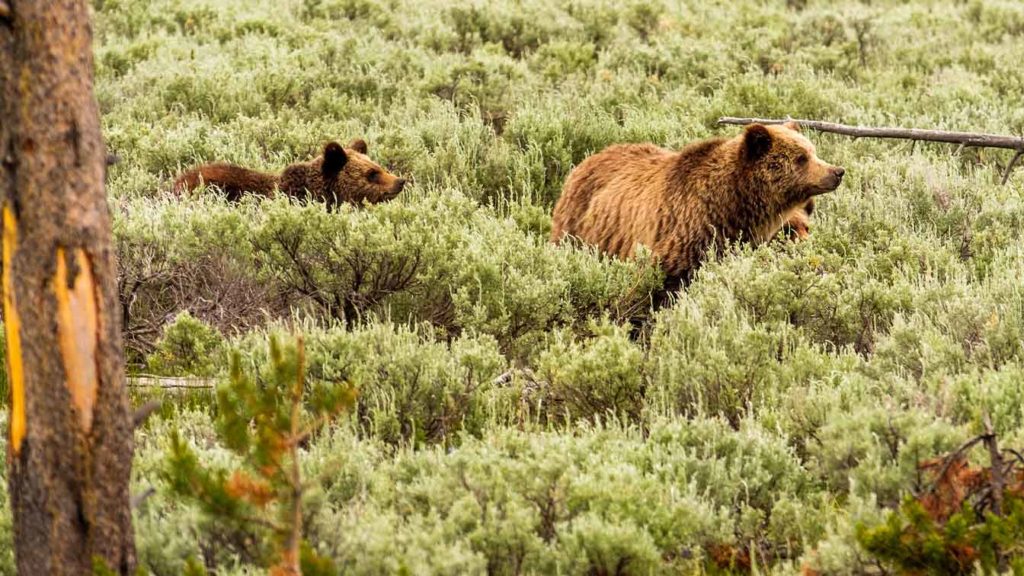If Republicans prevail in the midterm elections, Wyoming hunters could soon pursue grizzly bears, says a hunting advocate.
But that would be a bad idea, said an attorney for the Humane Society of the United States.
“The prospects of this legislation passing (to delist grizzly bears) hinge directly on the outcome of the midterm elections,” Mark Jones of Buffalo told Cowboy State Daily.
Jones is director of hunter programs for Gun Owners of America (GOA) and a wildlife biologist who worked for 30 years with the North Carolina Wildlife Research Commission.
Democrats probably won’t support delisting grizzlies, Jones said about a bill sponsored by U.S. Rep. Matt Rosedale, R-Montana, to have grizzly bears in Wyoming, Montana and Idaho removed from endangered species protection.
In the meantime, the governors of Wyoming, Montana and Idaho continue to lobby the U.S. Fish and Wildlife Service to delist grizzlies, Jones said.
Delisting grizzlies would be a bad idea, said Nicolas Arrivo of Chicago, managing attorney of animal protection litigation for the Humane Society of the United States.
Grizzlies might seem to be doing well in their core habitat in Yellowstone Park and the surrounding area, but they have yet to establish a regionally connected, genetically diverse population, he said. So, delisting and hunting the bruins now could set back decades of recovery efforts.

The Griz Season That Almost Was
A Wyoming grizzly hunting season nearly happened in 2018 before it was blocked by a federal judge at the behest of groups that include the Humane Society.
It would have authorized hunters to kill up to 22 grizzlies that year. The tags would have been $600 each for residents and $6,000 for out-of-state hunters.
By way of comparison, a nonresident grizzly tag in Alaska is $1,000 for the 2022 hunting season.
How Many Grizzlies Are Enough?
Arrivo and Jones offered differing views on grizzly bear hunting.
Jones said that having sport hunters cull grizzly numbers would be preferable to game wardens taking out bears that cause trouble.
Arrivo said there’s no evidence that hunting mitigates human-bear conflicts, citing a 2020 study by David J. Mattson. Matson is a retired researcher with the U.S. Geological Survey who specialized in studying grizzlies.
Among other things, the study suggests that better behavior by humans – such as not leaving tempting food sources easily accessible to bears – is the best way to prevent conflicts. The study claims there’s no evidence that hunting reduces human-bear conflicts.
However, grizzlies have long since exceeded their supposed recovery numbers in the Greater Yellowstone region, Jones said. The original target number was roughly 500 bears. By 2005, there were an estimated 600 grizzlies in the region, he said. Now, there are more than 1,000.
In November 2021, there were 1,069 grizzlies in the Greater Yellowstone Ecosystem demographic monitoring area, a Wyoming Game and Fish Department biologist told Cowboy State Daily.
That was the number cited for the demographic monitoring area by Game and Fish large carnivore specialist Dan Thompson. The monitoring area includes northwest Wyoming and parts of Montana and Idaho.
The number of grizzlies doesn’t tell the entire conservation story, Arrivo said. There are still plenty of wild areas, such as the Cascade Mountains in Washington and Oregon, that grizzlies could populate. Having an interconnected network of grizzly populations across a wider region would ensure genetic diversity among the bears.
Which Bears To Kill?
One problem with hunting is that hunters tend to target the largest male bears, or “trophy” grizzlies, Arrivo said. Those don’t tend to be the nuisance bears that game wardens kill for causing problems.
When those large, dominant males are taken out, it destabilizes the bear population, he said. Lesser males might move in, and they are more are apt to kill cubs and push female grizzlies to flee.
Jones said that while many hunters might want to kill only the largest bears, most won’t achieve that goal. Instead, they’re more likely to find the bears that are already causing trouble.
Those are usually smaller bears that have been pushed out of the core habitat and “aren’t as afraid around people,” he said.
In other words, many of the same bears that wardens must kill anyway, he said.
Conflicting Views About State Management
Wyoming, Montana and Idaho aren’t ready to manage grizzly bears because they aren’t focused on sound, long-term conservation, Arrivo said. Instead, the states are focused on hunting and not letting the bears expand their range.
Grizzlies used to range from Alaska all the way to northern Mexico, Arrivo said. While it’s not realistic to think grizzlies could reclaim all of that habitat, they are still being denied large sections of wild land where they could feasibly thrive.
The proposed state management “is not addressing the core problem of what’s causing conflict with humans and threating the bears’ long-term conservation,” Arrivo said. “Bears are facing decreasing core food sources, such as trout and white bark pine nuts.”
Until grizzly food source and habitat improvement is addressed, problems with bears won’t go away, and hunting wouldn’t make the situation any better, Arrivo said.
But state management, and hunting, are the best ways to conserve grizzlies, which continue to expand their range in Wyoming and across the region, Jones said.
The federal government “keeps moving the bar” regarding how many grizzlies amount to a fully recovered population, he said, adding he doesn’t want to see Wyoming end up like California.
“They’re taking out 300 mountain lions a year with paid government killers,” he said. “And they’re thinking they accomplished something by closing the mountain lion hunting season.”





